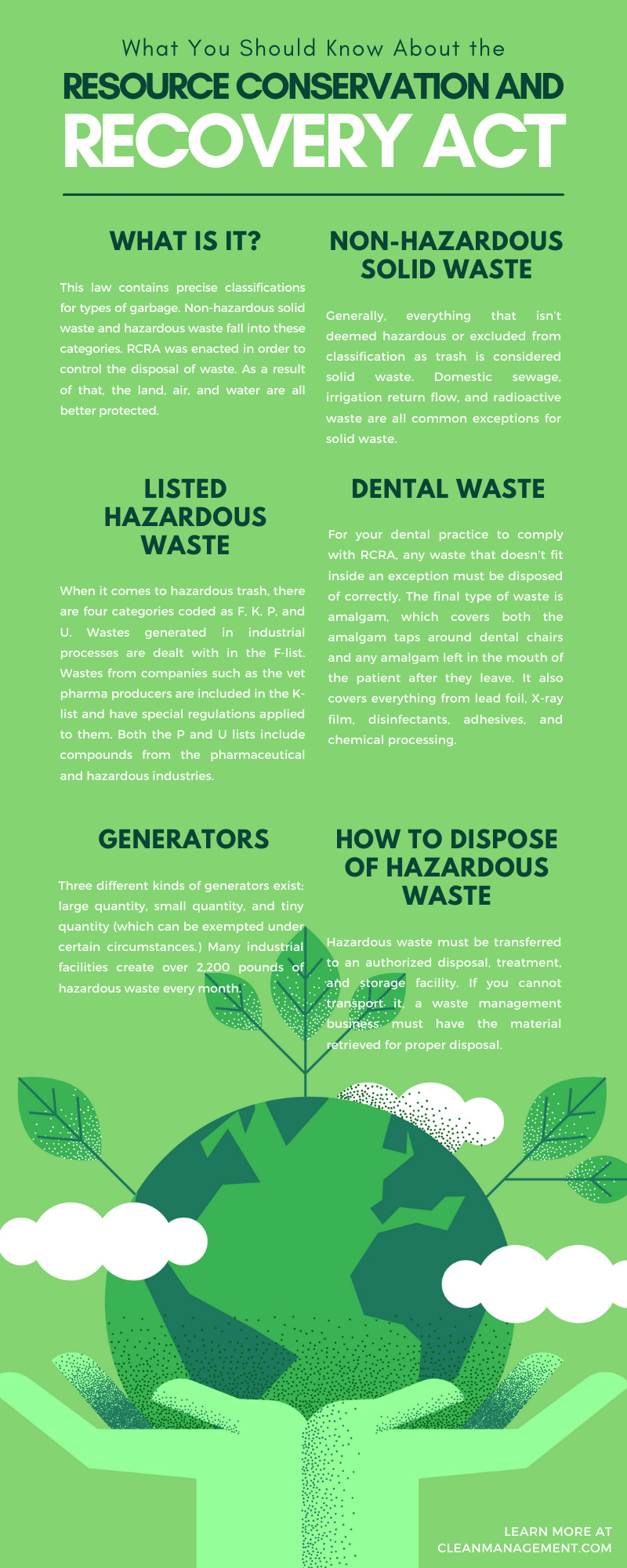What You Should Know About the Resource Conservation and Recovery Act (RCRA)

Most of the existing environmental safety legislation in the United States was passed in the 1970s. The Resource Conservation and Recovery Act (RCRA) was passed in 1976. Only a few environmental laws focus on particular kinds of trash, and RCRA is one of them. For example, there are laws requiring dentists to dispose of biological waste correctly. That’s right: along with waste management businesses, dentists are also regulated by RCRA.
Are you a bit fuzzy on RCRA and its application? To discover the specifics regarding it and understand how it’s used in dental offices and waste management businesses, keep reading.
What Is It?
Hazardous and solid waste disposal is the focus of the Resource Conservation and Recovery Act. The EPA is responsible for drafting and enforcing waste control rules, but not every kind of garbage is covered under RCRA. This law contains precise classifications for types of garbage. Non-hazardous solid waste and hazardous waste fall into these categories. RCRA was enacted in order to control the disposal of waste. As a result of that, the land, air, and water are all better protected.
Non-Hazardous Solid Waste
Waste that is not hazardous might be confusing, as the term “non-hazardous” isn’t necessarily correct— in fact, the waste could be liquid, or even gaseous. Generally, everything that isn’t deemed hazardous or excluded from classification as trash is considered solid waste. Domestic sewage, irrigation return flow, and radioactive waste are all common exceptions for solid waste. Don’t worry if something concerning is found on the list of exceptions; it’s likely an instance covered by separate legislation.
Listed Hazardous Waste
To help the EPA better identify dangerous trash, two tests were created. The first category is whether the waste appears on the EPA’s list of hazardous waste. The second criterion relies on whether the garbage possesses any dangerous properties.
When it comes to hazardous trash, there are four categories coded as F, K, P, and U. Wastes generated in industrial processes are dealt with in the F-list. Wastes from companies such as the vet pharma producers are included in the K-list and have special regulations applied to them. Both the P and U lists include compounds from the pharmaceutical and hazardous industries. Technical grade chemicals, pure chemicals, and single-ingredient chemicals are also available. These lists include a lot of substances like amalgam, which contain mercury, and are regularly used in dental practices.
Four Characteristics of Hazardous Waste
Ignitability
One of the waste’s characteristics is ignitability, which implies it’ll catch fire under certain circumstances. This includes liquids under sixty degrees Celsius in flashpoint and non-liquids that combust under particular conditions. These materials also include flammable compressed gases and oxidizers.
Corrosivity
The RCRA covers materials that demonstrate corrosive qualities. Generally, they have a pH ranging from 2 to 12.5. That means they can probably damage steel!
Reactivity
Reactive wastes are characterized as dangerous waste that’s constantly changing if kept at room temperature. They can create harmful gases or produce water. When heated, they’re likely to detonate or explode. Thus, proper disposal of such waste is absolutely vital.
Toxicity
Toxins are trash that is dangerous when consumed. If they aren’t properly disposed of, they pose a threat of polluting groundwater. Polluted groundwater can lead to sickness and death for people who rely on well water.
Dental Waste
For your dental practice to comply with RCRA, any waste that doesn’t fit inside an exception must be disposed of correctly. The final type of waste is amalgam, which covers both the amalgam taps around dental chairs and any amalgam left in the mouth of the patient after they leave. It also covers everything from lead foil, X-ray film, disinfectants, adhesives, and chemical processing. Dental offices must also ensure they safely dispose of toxic materials, such as fluorescent lamps, batteries, sterilizers, and disinfectants.
Don’t worry if you’re confused—RCRA is quite complex. Understanding covered wastes is easy if you go to the EPA website. They designed a flowchart you can use as a helpful guide when you’re figuring out whether any garbage you have in question is RCRA-regulated.
Generators
A generator is defined as something that creates energy by converting an external force. Three different kinds of generators exist: large quantity, small quantity, and tiny quantity (which can be exempted under certain circumstances.) Many industrial facilities create over 2,200 pounds of hazardous waste every month. The regulations governing their generators are fairly tough. For instance, getting an EPA identification number and regulations on garbage storage are mandatory procedures.
Hazardous waste is produced by generators that have outputs between 220 and 2,200 pounds per month. The regulations that govern LQGs apply to SQGs as well. They don’t have to fulfill requirements such as issuing a biennial report or putting employees through more training. If you don’t have a particularly large and active dental office, your small generator category is probably exempt from conditions. Generators in this category produce no more than two pounds of dangerous waste each month.
The least restrictive category is Conditionally Exempt Small Quantity Generator (CESQG.) You must identify any dangerous trash generated and ensure your hazardous garbage is delivered to a licensed hazardous waste manager.
How To Dispose of Hazardous Waste
Hazardous waste must be transferred to an authorized disposal, treatment, and storage facility. If you cannot transport it, a waste management business must have the material retrieved for proper disposal.
Dangerous trash is permitted to be stored onsite, but there must be less than 1000 kg of waste at a time. Be sure that hazardous waste isn’t mixed in with regular trash. Mixing them together risks creating more hazardous waste. You’d also run the risk of losing your status as a conditionally exempt small quantity generator, meaning you’d have to put a lot more work into your waste management plan.
Hopefully, by now you have a working understanding of the Resource Conservation and Recovery Act. There’s a lot more to it than what we’ve discussed here, but the things covered here are a great place to start. Whether you’re in the waste management business or a dentist who just learned a whole lot of new information, there’s a lot that you should know about the RCRA. If you’re not in these industries but need to hire a waste cleanup company for your business needs, visit us at Clean Management Environmental Group.

